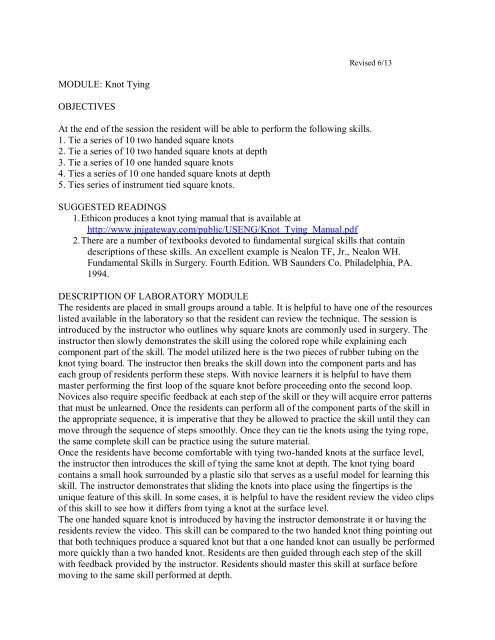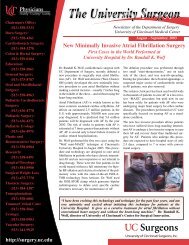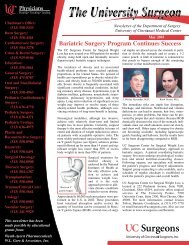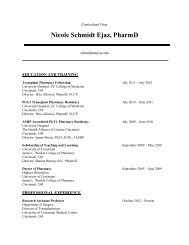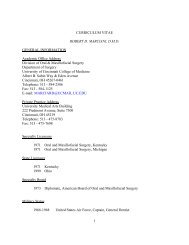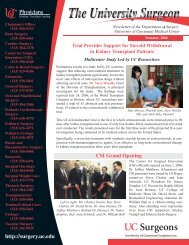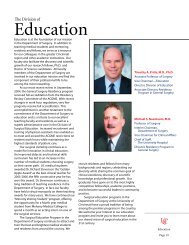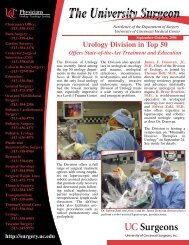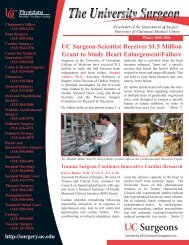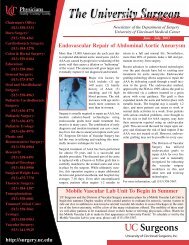Knot Tying Skills Lab - Surgery
Knot Tying Skills Lab - Surgery
Knot Tying Skills Lab - Surgery
Create successful ePaper yourself
Turn your PDF publications into a flip-book with our unique Google optimized e-Paper software.
Revised 6/13<br />
MODULE: <strong>Knot</strong> <strong>Tying</strong><br />
OBJECTIVES<br />
At the end of the session the resident will be able to perform the following skills.<br />
1. Tie a series of 10 two handed square knots<br />
2. Tie a series of 10 two handed square knots at depth<br />
3. Tie a series of 10 one handed square knots<br />
4. Ties a series of 10 one handed square knots at depth<br />
5. Ties series of instrument tied square knots.<br />
SUGGESTED READINGS<br />
1. Ethicon produces a knot tying manual that is available at<br />
http://www.jnjgateway.com/public/USENG/<strong>Knot</strong>_<strong>Tying</strong>_Manual.pdf<br />
2. There are a number of textbooks devoted to fundamental surgical skills that contain<br />
descriptions of these skills. An excellent example is Nealon TF, Jr., Nealon WH.<br />
Fundamental <strong>Skills</strong> in <strong>Surgery</strong>. Fourth Edition. WB Saunders Co. Philadelphia, PA.<br />
1994.<br />
DESCRIPTION OF LABORATORY MODULE<br />
The residents are placed in small groups around a table. It is helpful to have one of the resources<br />
listed available in the laboratory so that the resident can review the technique. The session is<br />
introduced by the instructor who outlines why square knots are commonly used in surgery. The<br />
instructor then slowly demonstrates the skill using the colored rope while explaining each<br />
component part of the skill. The model utilized here is the two pieces of rubber tubing on the<br />
knot tying board. The instructor then breaks the skill down into the component parts and has<br />
each group of residents perform these steps. With novice learners it is helpful to have them<br />
master performing the first loop of the square knot before proceeding onto the second loop.<br />
Novices also require specific feedback at each step of the skill or they will acquire error patterns<br />
that must be unlearned. Once the residents can perform all of the component parts of the skill in<br />
the appropriate sequence, it is imperative that they be allowed to practice the skill until they can<br />
move through the sequence of steps smoothly. Once they can tie the knots using the tying rope,<br />
the same complete skill can be practice using the suture material.<br />
Once the residents have become comfortable with tying two-handed knots at the surface level,<br />
the instructor then introduces the skill of tying the same knot at depth. The knot tying board<br />
contains a small hook surrounded by a plastic silo that serves as a useful model for learning this<br />
skill. The instructor demonstrates that sliding the knots into place using the fingertips is the<br />
unique feature of this skill. In some cases, it is helpful to have the resident review the video clips<br />
of this skill to see how it differs from tying a knot at the surface level.<br />
The one handed square knot is introduced by having the instructor demonstrate it or having the<br />
residents review the video. This skill can be compared to the two handed knot thing pointing out<br />
that both techniques produce a squared knot but that a one handed knot can usually be performed<br />
more quickly than a two handed knot. Residents are then guided through each step of the skill<br />
with feedback provided by the instructor. Residents should master this skill at surface before<br />
moving to the same skill performed at depth.
The instrument tied knot is that last skill taught in this module. The format is similar to that used<br />
for the other skills and so the instructor either demonstrates the entire skill or the residents can<br />
review it on the video. It is important during the introduction of the skill to outline where an<br />
instrument tied knot is appropriately used in surgery. This skill is practiced on the two pieces of<br />
rubber tubing on the knot tying board. Alternatively, the residents can use suture and practice the<br />
skill after placing a suture<br />
through a piece of foam or though pig skin. Usually by this point in the module, the residents<br />
have mastered the concept of a properly squared knot but it is still important to break the entire<br />
skill down into component parts and have them master the parts before practicing the entire skill.<br />
DESCRIPTION OF TECHNIQUES AND PROCEDURES<br />
The specific steps of each of the skills are outlined completely in all of the resources listed for<br />
this module. The overall goal of surgical knot tying is to efficiently produce a series of squared<br />
knots of sufficient strength to securely ligate a structure or approximate tissue. Mastery of these<br />
techniques results in safer surgery with minimal wastage of materials and time.<br />
COMMON ERRORS<br />
1. Two handed knot tying at surface. There are four major errors that occur with this<br />
technique.<br />
a. Too much motion in the right handed. Many novice learners will tend to use both<br />
hands equally in a fashion similar to tying one’s shoes. During the initial<br />
demonstration, it should be emphasized that the majority of the work is done with<br />
the left hand in two handed knot tying. If the resident persists in this error, it is<br />
sometimes helpful for the resident to use only the right hand while the instructor<br />
uses the left hand to cooperatively tie the knot. This allows the instructor to<br />
demonstrate that the right hand is only use to manipulate one of the stands of the<br />
suture material. The instructor can emphasize that using the right hand too much<br />
considerably slows the performance of this skill.<br />
b. Failure to maintain tension. As residents begin to gain speed in the task they will<br />
fail to maintain tension on the strands of suture throughout the entire skill. The<br />
instructor can prevent this problem by emphasizing that tension must be<br />
maintained during the initial demonstration. It is often helpful to have the<br />
residents slow their performance and concentrate on maintaining tension instead<br />
of gaining speed. Additionally, it can be explained that failure to maintain tension<br />
results in inadequate ligation of the structure or the formation “air knots” that<br />
decrease the security of the knot.<br />
c. Hands located to close to knots. This error substantially decreases efficiency as it<br />
becomes difficult to pass the strands of suture through the loop. It can be<br />
prevented by the instructor demonstrating that the suture should be grasped at a<br />
point that allows an adequate size looped to be formed.<br />
d. Failure to cross the suture. It is impossible to form a squared knot unless the<br />
resident crosses his or her hands or crosses the suture with their fingertips. This<br />
error can be prevented by demonstrating this fact. Using the rope, the instructor<br />
can demonstrate the failure to cross the suture results in a non- squared knot. The<br />
instructor can explain that the resulting knot will slip and outline the substantial<br />
complications that can occur if this occurs in an actual patient.
2. Two handed knot tying at depth. The new error that occurs when the knot is tied at depth is<br />
that the resident is not consistently slip the loop completely down. This result in gaps<br />
between the loops (e.g., air knots). This error can be prevent by explaining how it occurs<br />
during the initial demonstration and then emphasizing that the skill should be performed<br />
slowly with attention to slipping each loop securely into place.<br />
3. One handed knot tying at surface or depth. The same four errors that can occur with two<br />
handed knot tying can occur with this skill. In particular, residents will have difficult<br />
maintaining tension as they manipulate the strands of suture through the loop. This can be<br />
prevented by having the residents practice the skills at slow speeds with attention to<br />
maintaining tension.<br />
4. Instrument tying. The distinct error that residents can make with this skill relates to the<br />
length of the suture that is left for formation of the knot. If this suture “tail” is left too<br />
long, it makes manipulation cumbersome and thus creates inefficiencies. Further, it<br />
wastes suture materials. If the suture tail is left too short, it reduces speed as it becomes<br />
more difficult to grasp this small piece of suture and form the knot. These errors can be<br />
prevented by describing the optimal length of the tail of suture and outlining the<br />
consequences of either making the tail too long or too short.


